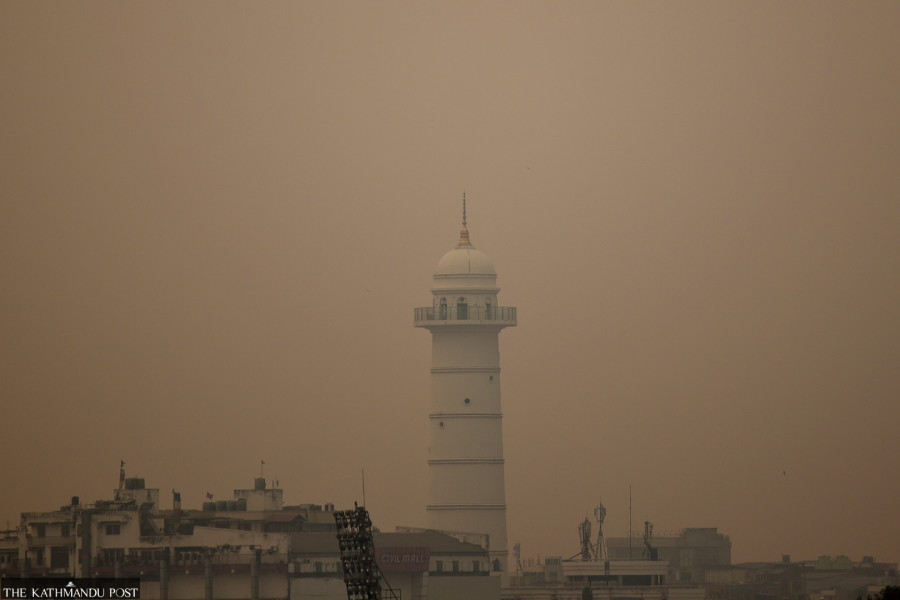Health
Kathmandu Valley’s toxic air exacerbates respiratory illness
With air quality deteriorating, experts warn of heightened risk of infection from viruses including the coronavirus.
Arjun Poudel
A few days ago, a 50-year-old woman from Kathmandu visited HAMS Hospital in Mandikhatar seeking treatment for her respiratory issues.
She complained of a common cold, cough, fever and difficulty in breathing. She told the doctor that she felt perfectly healthy while in Australia, but fell ill after returning to Nepal.
“The woman had been suffering from bronchitis when she arrived at our hospital,” said Dr Raju Pangeni, a senior consultant pulmonologist. “The toxic air and dust in the Kathmandu valley worsened her illness.”
This is a typical case of how respiratory problems can worsen on returning to Kathmandu. Doctors say many people end up in a hospital shortly after coming back from Europe or Australia. And what concerns them is the impact of toxic air and dust in Kathmandu, which makes people sick throughout the year.
“Generally, cases of respiratory illness surge during winter and as season changes throughout the world,” said Pangeni. “But in Nepal, people get sick throughout the year. This is not the usual season for rise in respiratory illness, but the decline in air quality has exacerbated the situation.”
The air quality in Kathmandu Valley has been worsening since Sunday due to the rise in forest fires across the country. According to IQAIR, a Swiss group that collects real-time air-quality data from around the globe, particulate matter pollution (PM2.5) levels of the Valley on Sunday reached hazardous levels—413 micrograms per cubic metre—making the national capital the most polluted city in the world.
The air quality had slightly improved but remained concerning with PM2.5 at 250 micrograms per cubic metre on Monday and 223 micrograms per cubic metre on Tuesday, a very unhealthy level.
PM2.5 refers to particulate matter or solid and liquid droplets in the air that are less than 2.5 micrometres, or 400th of a millimetre, in diameter. As per the United States Environment Protection Agency’s air quality index, when air pollutant PM2.5 exceeds 300 μg/m3, the level is considered ‘hazardous’ for everyone and may prompt emergency condition alerts. When air pollutant PM2.5 reaches 201 to 300 μg/m3, air quality is considered very unhealthy; everyone may experience problems, with sensitive groups experiencing more severe effects.
The Kathmandu Valley’s Air Pollution Management Action Plan provides that the authorities can declare a public health emergency whenever AQI readings exceed 300. However, none of the agencies concerned has considered declaring a public health emergency to mitigate the impact of air pollution.
Along with those returning from Europe and Australia, people returning from India, which witnessed deterioration in air quality in recent months, have also suffered from respiratory illness.
On Monday, a 65-year-old man from Kathmandu, who had recently returned from India, was rushed to HAMS Hospital. Doctors attending the patient said that his oxygen level had dropped to 65 by the time he was brought to the hospital.
Doctors say air pollution is known to cause various respiratory illnesses. Poor air quality can cause short- and long-term effects on public health. In the short term, it can lead to pneumonia, bronchitis, conjunctivitis, skin allergy, stroke, and heart problems, and in the long run it can lead to severe conditions like ulcers, and cancer of the lungs and intestine, kidney disease, and heart complications.
Experts advise people at risk including children, pregnant women, elderly and those with respiratory illnesses to avoid all outdoor activities.
“Even young and healthy people could suffer from respiratory problems when air quality plummets to hazardous levels,” said Pangeni. “People should avoid outdoor activities if the air quality is hazardous.”
Along with a surge in cases of infection of seasonal flu and respiratory illness, major hospitals in the Valley have recently seen an uptick in Covid infections. Doctors say the worsening air quality could contribute to the further spread of the coronavirus in communities.
“We should not forget that the coronavirus has been circulating in our communities,” said Dr Sher Bahadur Pun, chief of clinical research unit at the Sukraraj Tropical and Infectious Disease Hospital. “The risk of getting infected with multiple viruses including the coronavirus increases when air quality deteriorates.”
The declining air quality in the Kathmandu Valley could be one of the factors in the sharp increase in respiratory problems, including exacerbating the severity of coronavirus cases, according to doctors.
Experts advise people to avoid exposure to pollution and wear face masks when venturing outdoors.




 13.12°C Kathmandu
13.12°C Kathmandu














